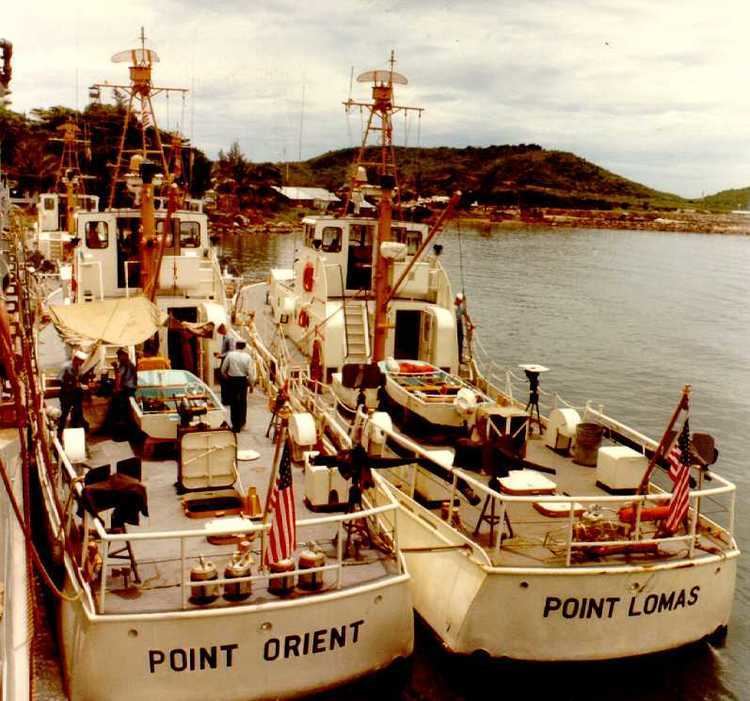Commissioned 9 August 1961 Length 25 m Displacement 54,430 kg | Decommissioned 23 May 1970 Weight 61 tons | |
 | ||
Name USCGC Point Lomas (WPB-82321) Namesake Point Loma, near San Diego, California Owner United States Coast Guard Honors and
awards Navy Unit Commendation
Meritorious Unit Commendation (Navy)
Vietnam Service Medal with 2 silver and 2 bronze service stars Builders United States Coast Guard Yard, Curtis Bay, Balti | ||
USCGC Point Lomas (WPB-82321) was an 82-foot (25 m) Point class cutter constructed at the Coast Guard Yard at Curtis Bay, Maryland in 1961 for use as a law enforcement and search and rescue patrol boat. Since the Coast Guard policy in 1961 was not to name cutters under 100 feet (30 m) in length, it was designated as WPB-82321 when commissioned and acquired the name Point Lomas in January 1964 when the Coast Guard started naming all cutters longer than 65-foot (20 m) .
Contents
Construction and design details
Point Lomas was built to accommodate an 8-man crew. She was powered by two 600 hp (447 kW) VT600 Cummins diesel main drive engines and had two five-bladed 42 in (1.1 m) propellers. The main drive engines were later replaced by 800 hp (597 kW) VT800 Cummins engines. Water tank capacity was 1,550 U.S. gallons (5,900 L) and fuel tank capacity was 1,840 U.S. gallons (7,000 L) at 95% full. Engine exhaust was ported through the transom rather than through a conventional stack and this permitted a 360 degree view from the bridge; a feature that was very useful in search and rescue work as well as a combat environment.
The design specifications for Point Lomas included a steel hull for durability and an aluminum superstructure and longitudinally framed construction was used to save weight. Ease of operation with a small crew size was possible because of the non-manned main drive engine spaces. Controls and alarms located on the bridge allowed one man operation of the cutter thus eliminating a live engineer watch in the engine room. Because of design, four men could operate the cutter; however, the need for resting watchstanders brought the crew size to eight men for normal domestic service. The screws were designed for ease of replacement and could be changed without removing the cutter from the water. A clutch-in idle speed of three knots helped to conserve fuel on lengthy patrols and an eighteen knot maximum speed could get the cutter on scene quickly. Air-conditioned interior spaces were a part of the original design for the Point class cutter. Interior access to the deckhouse was through a watertight door on the starboard side aft of the deckhouse. The deckhouse contained the cabin for the officer-in-charge and the executive petty officer. The deckhouse also included a small arms locker, scuttlebutt, a small desk and head. Access to the lower deck and engine room was down a ladder. At the bottom of the ladder was the galley, mess and recreation deck. A watertight door at the front of the mess bulkhead led to the main crew quarters which was ten feet long and included six bunks that could be stowed, three bunks on each side. Forward of the bunks was the crew's head complete with a compact sink, shower and commode. Accommodations for a 13-man crew were installed for Vietnam service.
History
After delivery in 1961, Point Lomas was assigned a homeport of Port Aransas, Texas, where she served as a law enforcement and search and rescue patrol boat.
At the request of the United States Navy, in April 1965, she was alerted for service in Vietnam and assigned to Coast Guard Squadron One in support of Operation Market Time along with 16 other Point class cutters. While the crew completed overseas training and weapons qualifications at Coast Guard Island and Camp Parks, California, Point Lomas was loaded onto a merchant ship, and transported to Subic Bay, Philippines in May 1965 where she was refit for combat service. Shipyard modifications included installation of new single-sideband radio equipment, additional floodlights, small arms lockers, additional sound-powered phone circuits, and the addition of four M-2 machine guns. The original bow mounted machine gun was replaced with a combination over-under 50 caliber machine gun/81mm trigger fired mortar that had been developed by the Coast Guard for service in Vietnam. For service in Vietnam, two officers were added to the crew complement to add seniority to the crew in the mission of interdicting vessels at sea.
Point Lomas was assigned to Division 12 of Squadron One to be based at Danang, along with Point Arden, Point Caution, Point Dume, Point Ellis, Point Gammon, Point Orient and Point Welcome. After sea trials, the Division left Subic Bay for Danang on 16 July 1965 in the company of USS Snohomish County (LST-1125), their temporary support ship. After almost two weeks at sea, they arrived at their new duty station on 20 July and began patrolling the coastal waters near Danang Duty consisted of boarding Vietnamese junks to search for contraband weapons and ammunition and check the identification papers of persons on board. Permanent engineering and logistic support of Division 12 was provided by a U.S. Navy non-self-propelled floating workshop, YR-71. During this time, the WPB's were directed to paint the hulls and superstructures formula 20 deck gray to cover the stateside white paint. This increased the effectiveness of night patrols.
On 1 May 1968 Point Lomas assisted USS Valley Forge (LPH-8) in the rescue of the crew of a helicopter that crashed at sea off the coast near Huế.
On 23 May 1970, Point Lomas was given to the Republic of Vietnam Navy and recommissioned as HQ-718.
